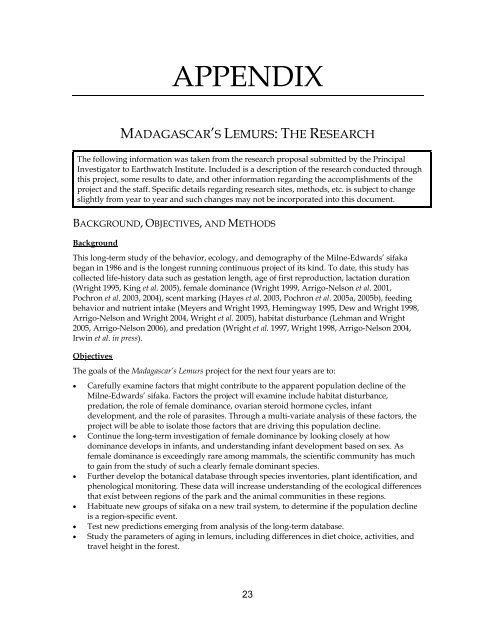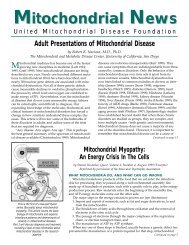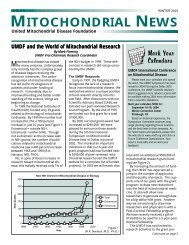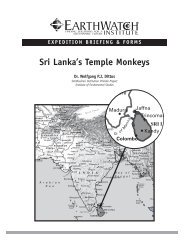Madagascar's Lemurs
Madagascar's Lemurs
Madagascar's Lemurs
Create successful ePaper yourself
Turn your PDF publications into a flip-book with our unique Google optimized e-Paper software.
APPENDIX<br />
MADAGASCAR’S LEMURS: THE RESEARCH<br />
The following information was taken from the research proposal submitted by the Principal<br />
Investigator to Earthwatch Institute. Included is a description of the research conducted through<br />
this project, some results to date, and other information regarding the accomplishments of the<br />
project and the staff. Specific details regarding research sites, methods, etc. is subject to change<br />
slightly from year to year and such changes may not be incorporated into this document.<br />
BACKGROUND, OBJECTIVES, AND METHODS<br />
Background<br />
This long-term study of the behavior, ecology, and demography of the Milne-Edwards’ sifaka<br />
began in 1986 and is the longest running continuous project of its kind. To date, this study has<br />
collected life-history data such as gestation length, age of first reproduction, lactation duration<br />
(Wright 1995, King et al. 2005), female dominance (Wright 1999, Arrigo-Nelson et al. 2001,<br />
Pochron et al. 2003, 2004), scent marking (Hayes et al. 2003, Pochron et al. 2005a, 2005b), feeding<br />
behavior and nutrient intake (Meyers and Wright 1993, Hemingway 1995, Dew and Wright 1998,<br />
Arrigo-Nelson and Wright 2004, Wright et al. 2005), habitat disturbance (Lehman and Wright<br />
2005, Arrigo-Nelson 2006), and predation (Wright et al. 1997, Wright 1998, Arrigo-Nelson 2004,<br />
Irwin et al. in press).<br />
Objectives<br />
The goals of the Madagascar’s <strong>Lemurs</strong> project for the next four years are to:<br />
• Carefully examine factors that might contribute to the apparent population decline of the<br />
Milne-Edwards’ sifaka. Factors the project will examine include habitat disturbance,<br />
predation, the role of female dominance, ovarian steroid hormone cycles, infant<br />
development, and the role of parasites. Through a multi-variate analysis of these factors, the<br />
project will be able to isolate those factors that are driving this population decline.<br />
• Continue the long-term investigation of female dominance by looking closely at how<br />
dominance develops in infants, and understanding infant development based on sex. As<br />
female dominance is exceedingly rare among mammals, the scientific community has much<br />
to gain from the study of such a clearly female dominant species.<br />
• Further develop the botanical database through species inventories, plant identification, and<br />
phenological monitoring. These data will increase understanding of the ecological differences<br />
that exist between regions of the park and the animal communities in these regions.<br />
• Habituate new groups of sifaka on a new trail system, to determine if the population decline<br />
is a region-specific event.<br />
• Test new predictions emerging from analysis of the long-term database.<br />
• Study the parameters of aging in lemurs, including differences in diet choice, activities, and<br />
travel height in the forest.<br />
23

















